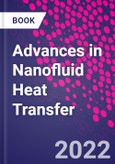Advances in Nanofluid Heat Transfer covers the broad definitions, brief history, preparation techniques, thermophysical properties, heat transfer characteristics, and emerging applications of hybrid nanofluids. Starting with the basics, this book advances step-by-step toward advanced topics, with mathematical models, schematic diagrams and discussions of the experimental work of leading researchers. By introducing readers to new techniques, this book helps readers resolve existing problems and implement nanofluids in innovative new applications.
This book provides detailed coverage of stability and reliable measurement techniques for nanofluid properties, as well as different kinds of base fluids. Providing a clear understanding of what happens at the nanoscale, the book is written to be used by engineers in industry as well as researchers and graduate students.
Please Note: This is an On Demand product, delivery may take up to 11 working days after payment has been received.
Table of Contents
1.Experimental correlations for Nusselt number and friction factor of nanofluids
2. Stability of nanofluids in heat transfer
3. Synthesis, characterization, and measurement techniques for the thermophysical properties of nanofluids
4. Thermophysical and rheological properties of unitary and hybrid nanofluids
5. Comparison of physical properties enhancement in various heat transfer nanofluid by MXene
6. Numerical modeling of nanofluids' flow and heat transfer
7. Recent advances in machine learning research for nanofluid heat transfer in renewable energy
8. Heat transfer enhancement with nanofluids in automotive
9. Harvesting solar energy by nanofluids and antibacterial activity via nanofluids
10. Application of nanofluids in combustion engines with focusing on improving heat transfer process
11. Applications of nanofluids in solar energy collectors focusing on solar stills, advances in nanofluid heat transfer
12. Utilization of nanofluids (mono and hybrid) in parabolic trough solar collector: a comparative analysis
13. Electronics thermal management applying heat pipes and pulsating heat pipes
14. Role of nanofluids in microchannel heat sinks
15. Nanofluids for enhanced performance of building thermal energy systems
16. Ionic nanofluids: preparation, characteristics, heat transfer mechanism, and thermal applications
17. Hybrid nanofluids towards advancement in nanofluids for heat sink








